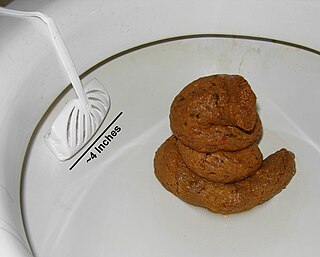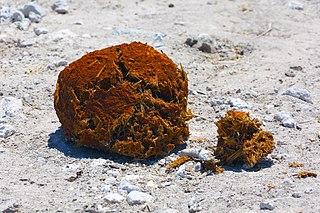Related Research Articles

The fecal–oral route describes a particular route of transmission of a disease wherein pathogens in fecal particles pass from one person to the mouth of another person. Main causes of fecal–oral disease transmission include lack of adequate sanitation, and poor hygiene practices. If soil or water bodies are polluted with fecal material, humans can be infected with waterborne diseases or soil-transmitted diseases. Fecal contamination of food is another form of fecal-oral transmission. Washing hands properly after changing a baby's diaper or after performing anal hygiene can prevent foodborne illness from spreading.
Plesiomonas shigelloides is a species of bacteria that was formerly classified in the family Vibrionaceae, but now most microbiologists agree that a better classification is in the family Enterobacteriaceae. It is a Gram-negative, rod-shaped bacterium which has been isolated from freshwater, freshwater fish, and shellfish and from many types of animals including humans, cattle, goats, swine, cats, dogs, monkeys, vultures, snakes, and toads.
The coliform index is a rating of the purity of water based on a count of fecal bacteria. It is one of many tests done to assure sufficient water quality. Coliform bacteria are microorganisms that primarily originate in the intestines of warm-blooded animals. By testing for coliforms, especially the well known Escherichia coli, which is a thermotolerant coliform, one can determine if the water has possibly been exposed to fecal contamination; that is, whether it has come in contact with human or animal feces. It is important to know this because many disease-causing organisms are transferred from human and animal feces to water, from where they can be ingested by people and infect them. Water that has been contaminated by feces usually contains pathogenic bacteria, which can cause disease. Some types of coliforms cause disease, but the coliform index is primarily used to judge if other types of pathogenic bacteria are likely to be present in the water.
Eggerthella is a bacterial genus of Actinobacteria, in the family Coriobacteriaceae. Members of this genus are anaerobic, non-sporulating, non-motile, Gram-positive bacilli that grow singly, as pairs, or in short chains. They are found in the human colon and feces and have been implicated as a cause of ulcerative colitis, liver and anal abscesses and systemic bacteremia.

Human feces are the solid or semisolid remains of the food that could not be digested or absorbed in the small intestine of humans, but has been rotted down by bacteria in the large intestine. It also contains bacteria and a relatively small amount of metabolic waste products such as bacterially altered bilirubin, and the dead epithelial cells from the lining of the gut. It is discharged through the anus during a process called defecation. Human feces have similarities to feces of other animals and vary significantly in appearance, according to the state of the diet, digestive system and general health. Normally human feces are semisolid, with a mucus coating. Small pieces of harder, less moist feces can sometimes be seen impacted in the distal end. This is a normal occurrence when a prior bowel movement is incomplete, and feces are returned from the rectum to the large intestine, where water is absorbed.
Solobacterium moorei is a bacterium that has been identified as a contributor to halitosis. It is a gram-positive anaerobic bacillus, erroneously known as Bulleidia moorei, in the family Erysipelotrichaceae of the order Erysipelotrichales. This particular strain was identified by Kageyama and Benno in 2000, previously an unclassified Clostridium group RCA59.

Feces are the solid or semisolid remains of the food that could not be digested in the small intestine. Bacteria in the large intestine further break down the material. Feces contain a relatively small amount of metabolic waste products such as bacterially altered bilirubin, and the dead epithelial cells from the lining of the gut.

Urine diversion, also called urine separation or source separation, refers to the separate collection of human urine and feces at the point of their production, i.e. at the toilet or urinal. Separation of urine from feces allows human waste to be treated separately and used as a potential resource. Applications are typically found where connection to a sewer-based sanitation system is not available or areas where water supplies are limited.
Akkermansia is a genus in the phylum Verrucomicrobia (Bacteria). The genus was first proposed in 2004 by Muriel Derrien and others, with the type species Akkermansia muciniphila.
Alkalibacillus is a genus in the phylum Firmicutes (Bacteria).
Escherichia coli O104:H4 is an enteroaggregative Escherichia coli strain of the bacterium Escherichia coli, and the cause of the 2011 Escherichia coli O104:H4 outbreak. The "O" in the serological classification identifies the cell wall lipopolysaccharide antigen, and the "H" identifies the flagella antigen.

A urine-diverting dry toilet (UDDT) is a type of dry toilet with urine diversion that can be used to provide safe, affordable sanitation in a variety of contexts worldwide. Through the separate collection of feces and urine without any flush water, many advantages can be realized, such as odor-free operation and pathogen reduction by drying. While dried feces and urine harvested from UDDTs can be and routinely are used in agriculture, many UDDTs installations do not apply any sort of recovery scheme. The UDDT is an example of a technology that can be used to achieve a sustainable sanitation system. This dry excreta management system is an alternative to pit latrines and flush toilets, especially where water is scarce, a connection to a sewer system and centralized wastewater treatment plant is not feasible or desired, fertilizer and soil conditioner are needed for agriculture, or groundwater pollution should be minimized.
Allobaculum stercoricanis is an anaerobic, non-spore-forming and rod-shaped bacterium from the genus of Allobaculum which has been isolated from feces from a dog.´
Coprobacillus cateniformis is a bacterium from the genus of Coprobacillus which has been isolated from human feces in Japan.
Holdemania fmassiliensis is a Gram-positive, anaerobic, non-spore-forming and non-motile bacterium from the genus of Holdemania which has been isolated from human feces.
Barnesiella intestinihominis is a Gram-negative, anaerobic and non-spore-forming bacterium from the genus of Barnesiella which has been isolated from human feces in Tokyo, Japan.
Anaerofustis is a Gram-positive, strictly anaerobic, rod-shaped and non-spore-forming bacterial genus from the family of Eubacteriaceae with one known species. Anaerofustis stercorihominis was isolated from human feces.
Nocardioides massiliensis is a bacterium from the genus Nocardioides which has been isolated from human feces from Marseille in France.
Alkalibacillus filiformis is a Gram-positive, haloalkaliphilic and non-motile bacterium from the genus of Alkalibacillus which has been isolated from water and mud from Malvizza, Montecalvo Irpino, Italy.
References
- 1 2 Parte, A.C. "Holdemania". www.bacterio.net.
- 1 2 "Holdemania filiformis". www.uniprot.org.
- ↑ "Details: DSM-12042". www.dsmz.de.
- ↑ Willems, A.; Moore, W. E. C.; Weiss, N.; Collins, M. D. (1 October 1997). "Phenotypic and Phylogenetic Characterization of Some Eubacterium-Like Isolates Containing a Novel Type B Wall Murein from Human Feces: Description of Holdemania filiformis gen. nov., sp. nov". International Journal of Systematic Bacteriology. 47 (4): 1201–1204. doi:10.1099/00207713-47-4-1201. PMID 9336928.